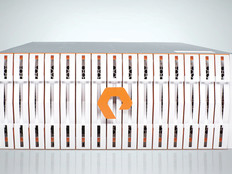Software-Defined Networks Set the Stage for Data Center Transformations
Software-defined networks do more than enable next-gen capabilities for LANs and WANs. For many higher education institutions, SDNs are a building block for software-defined data center technology, a broader architecture with software controls that manage other critical components of IT operations. SDDC spans virtual machines and server clusters, security tools, and software-defined storage systems that combine multiple flash and spinning-disk drives into one big pool of available capacity.
SIGN UP: Get more news from the EdTech newsletter in your inbox every two weeks!
Fast, Flexible Data Center Management
Campus IT teams are investigating SDDC because its orchestration and automation capabilities enable cloudlike, self-service provisioning and centralized data center management.
One early adopter is the University of New Mexico in Albuquerque. UNM staff turned to an SDDC, enabled by VMware NSX and VMware vRealize Automation, to speed service delivery and improve security. The data center, together with other modernizations in recent years, made it possible to create a self-service portal that lets staff and faculty bring up new computing resources in about 20 minutes, without IT’s help.
“We’re now able to tee up services in a way that is seamless and easy, so we can be more responsive to the campus’s needs,” says CIO Duane Arruti. “By automating everything, we’ve been able to expand some IT services without having to hire additional staff to deliver them.”
Enhanced security is critical for departments that manage highly regulated or sensitive data. By automating security tasks, IT can centrally apply policies throughout the institution to ensure they’re in place everywhere they’re needed.
“Data protection has improved many times over what we had in the past,” says UNM’s Deputy CIO Brian Pietrewicz. “We’re now able to manage security in a much more granular way.”
Software-Defined Data Center Supports Scalability
Having SDDC as a foundation also sets the stage for UNM’s next moves, including a possible shift to public clouds, Pietrewicz says.
As part of the VMware NSX rollout, UNM turned to Arista Networks for Layer 3 switches, which essentially act as routers that forward traffic faster than older Layer 2 models. The combination of software abstraction and new physical devices lets the IT staff scale the network more effectively to meet changing workload levels.
“We don’t have to worry about which virtual LANs are running to which hosts because the control layer is abstracted and sits on top of the networking hardware,” Pietrewicz says.
Other institutions may see similar benefits from SDDC, but before they move in that direction, Pietrewicz cautions them to first put solid workflows in place.
“Everybody thinks about the technology, but that’s not the real challenge,” he says. “The focus should be on processes and nailing down exactly how you provision services in your operation. Initially, we weren’t a process-oriented shop, and it took us months to standardize processes so we could automate them.”
To learn more about software-defined platforms in higher education, read our magazine feature, "SDN Technology Increases Speed, Visibility for Campus IT."









